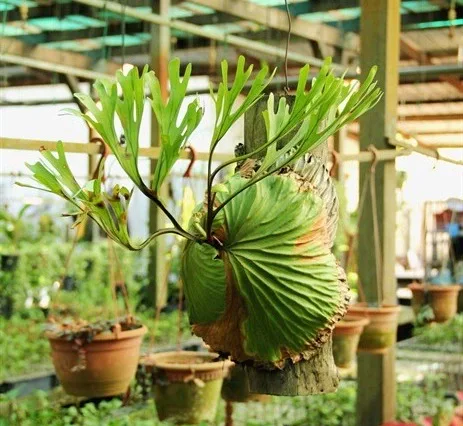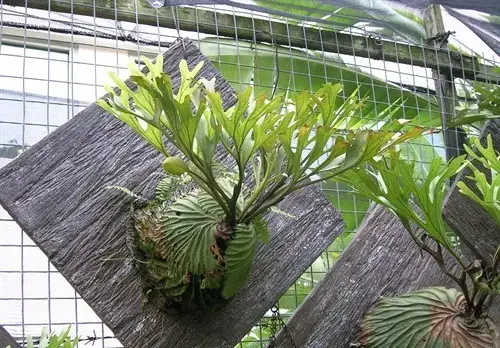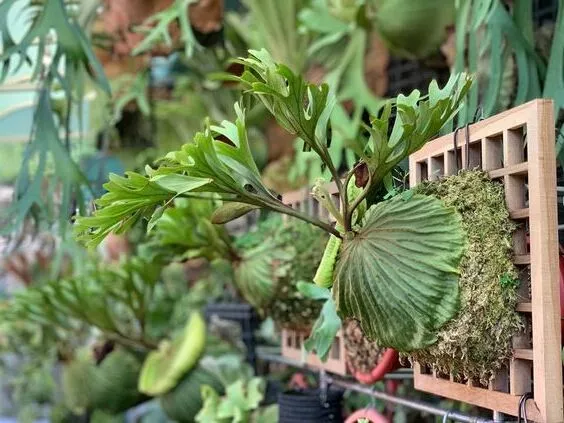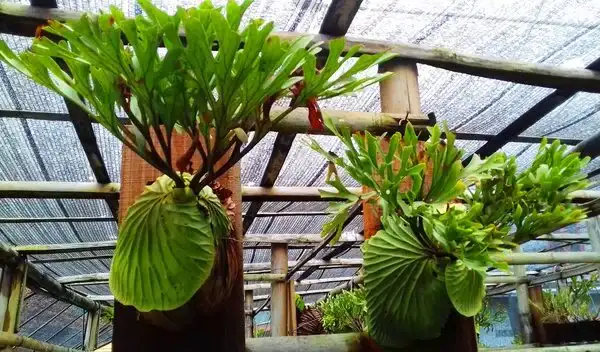Platycerium Ridleyi, commonly known as Ridley’s Staghorn Fern, is a unique fern species that is well-loved by indoor plant enthusiasts. This fern species is known for its large, antler-shaped fronds that can grow up to three feet long, making it a show-stopping addition to any indoor garden.
Platycerium Ridleyi is native to New Guinea and other areas of tropical Southeast Asia. In the wild, this fern species can be found growing on tree trunks and rocks, as well as on the ground. As an epiphyte, it attaches itself to surfaces without taking any nutrients from its host plant.
| Common Name: | Ridley’s Staghorn Fern |
|---|---|
| Scientific Name: | Platycerium Ridleyi |
| Family: | Polypodiaceae |
| Plant Type: | Epiphytic and terrestrial fern |
| Origin: | New Guinea and tropical Southeast Asia |
Platycerium Ridleyi’s unique fronds are responsible for its common name, as they resemble the antlers of a male deer or stag. The fronds are two-dimensional, and their broad surface catches rainfall and organic debris, allowing the fern to absorb nutrients. Additionally, the plant’s extensive rhizome system allows it to store water, making it highly adaptable to different environments.

Growing Platycerium Ridleyi Indoors
If you’re wondering how to care for Platycerium Ridleyi, we’ve got you covered. Growing this unique fern species indoors requires some knowledge, but it’s not too difficult with the right conditions and care.
The first step is finding the right spot for your Ridley’s Staghorn Fern. It thrives in bright, indirect light, making it a great addition to an east- or west-facing window. However, keep it out of direct sun, as it can scorch the fronds.
The temperature range for this fern species should be between 60°F-80°F (15°C-27°C). Keep in mind that Ridley’s Staghorn Fern does not tolerate sudden changes in temperature, so avoid placing it near drafty areas or heating/cooling vents.
Humidity is also an essential factor to consider when growing Platycerium Ridleyi indoors. This fern species thrives in high humidity environments, so it’s best to keep it in a room with a humidity level of at least 50%. You can also increase humidity by placing a tray of pebbles and water near the plant or misting it regularly.
When it comes to potting media, Ridley’s Staghorn Fern prefers a mixture of orchid bark, sphagnum moss, and perlite. This combination provides adequate drainage and aeration to the plant’s roots. You can also mount your fern on a board or piece of wood and use sphagnum moss to hold it in place.
When watering this fern species, it’s important to maintain consistent moisture levels without overwatering. Water once a week, or more often if the top layer of soil feels dry to the touch. Always water at the base of the plant, avoiding the fronds, as they can easily rot if kept wet for too long.
In terms of fertilizers, Ridley’s Staghorn Fern benefits from a balanced, slow-release fertilizer applied during the growing season (spring to early autumn). Be sure to follow the instructions on the packaging and avoid overfeeding, as it can lead to burned roots.
With proper care, Ridley’s Staghorn Fern can provide a unique and eye-catching addition to your indoor garden.

Watering and Fertilizing Ridley’s Staghorn Fern
Proper watering and fertilizing are essential for the health and growth of Platycerium Ridleyi. Here are some tips to help you keep your Ridley’s Staghorn Fern thriving:
Watering Ridley’s Staghorn Fern
Platycerium Ridleyi prefers moist soil, but be careful not to overwater. Too much water can cause the roots to rot and lead to other problems. Water your Ridley’s Staghorn Fern when the top layer of soil feels dry to the touch. You can test the moisture level by sticking your finger into the soil about an inch deep. If it feels dry, it’s time to water.
When watering, make sure to moisten the entire root ball, including the growing media and any dead leaves that are attached to the fronds. Use a watering can or a hose with a gentle flow to avoid damaging the plant. If you have mounted your fern on a board, soak the board in water for a few minutes until it is thoroughly saturated.
It’s important to note that Platycerium Ridleyi is sensitive to the quality of the water it receives. The fern prefers rainwater or distilled water, as tap water can contain chemicals like chlorine and fluoride that can harm the plant over time.
Fertilizing Ridley’s Staghorn Fern
Platycerium Ridleyi requires regular fertilization to grow healthy and strong. Feed your fern with a balanced fertilizer every month, from spring to autumn. During the winter, reduce the frequency to every six to eight weeks.
Use a water-soluble fertilizer, and make sure to dilute it to half the recommended strength. Avoid getting the fertilizer on the fronds, as it can burn them. Apply the fertilizer to the soil around the base of the plant instead.
Remember to water your Ridley’s Staghorn Fern before applying fertilizer. This will ensure that the nutrients are properly absorbed and distributed throughout the plant.
Maintaining Humidity for Platycerium Ridleyi
Platycerium Ridleyi thrives in high humidity environments and requires consistent moisture to stay healthy and lush. If you live in a dry climate or don’t have a naturally humid environment, you’ll need to take additional steps to maintain a suitable level of moisture for your Ridley’s Staghorn Fern.
Methods for Increasing Humidity
One of the easiest ways to increase humidity around your fern is to mist it regularly with water. Simply fill a spray bottle with distilled water and mist the leaves and fronds several times a day to keep them moist. You can also use a pebble tray to create a humid microclimate around your fern. Fill a shallow tray with pebbles and water, then place your plant on top. As the water evaporates, it will create a humid environment around the fern.
If you want to maintain a consistently high level of humidity, you can invest in a humidifier. There are many types of humidifiers available, from large units that can humidify an entire room to smaller, more portable options. Place the humidifier near your Platycerium Ridleyi and run it regularly to maintain a constant level of moisture.
How to Monitor Humidity Levels
To ensure that your Ridley’s Staghorn Fern is getting the right amount of humidity, you can use a hygrometer to measure the moisture in the air. A hygrometer is a simple tool that measures the relative humidity in a room. Place the hygrometer near your fern and check it regularly to make sure that the humidity is within the recommended range.
By taking steps to maintain a high level of humidity, you can help your Platycerium Ridleyi thrive and grow into a beautiful, healthy plant.

Propagating Platycerium Ridleyi
One of the most rewarding aspects of caring for Platycerium Ridleyi is the ability to propagate new plants. There are two main propagation methods – spore propagation and division.
Spore Propagation
To propagate Platycerium Ridleyi from spores, you will need to collect mature spores from the underside of the fern’s fronds. Place the spores in a container with moist sphagnum moss and cover it to create a humid environment. Keep the container in bright, indirect light and maintain adequate moisture levels until the spores germinate.
Division
Division is the process of separating the fern into smaller sections, each with its own fronds and roots. To divide Platycerium Ridleyi, remove the fern from its container and gently separate the root ball into smaller sections. Be careful to avoid damaging the fronds or roots. Once divided, plant each section into its own pot with appropriate potting media.
Propagation can be a slow process, but with patience and care, you can enjoy the growth and development of new Ridley’s Staghorn Fern plants.
Common Pests and Diseases
Like other indoor plants, Platycerium Ridleyi can be susceptible to pests and diseases. Here are some of the most common issues to watch out for:
| Pest/Disease | Description | Treatment/Prevention |
|---|---|---|
| Scale insects | Small, brown or white insects that attach themselves to the fronds and suck out sap, causing damage. | Remove scale insects manually with a soft brush or cotton swab dipped in rubbing alcohol. Use insecticidal soap or neem oil to control infestations. |
| Mealybugs | Soft, white, cottony insects that feed on plant sap and produce a sticky substance known as honeydew. They can cause stunted growth and yellowing of the fronds. | Remove mealybugs by hand and wash the affected area with a solution of water and dish soap. Use insecticidal soap or neem oil to control infestations. |
| Fungal infections | Fungal infections like root rot and leaf spot can occur due to overwatering or poor ventilation. Signs include yellow, brown, or black spots on the fronds. | Remove infected leaves and improve air circulation. Ensure proper drainage and avoid overwatering. Use a fungicide if necessary. |
It’s important to catch and treat pest infestations and fungal infections early to prevent them from spreading and causing extensive damage to the plant.
To prevent these issues, practice good plant hygiene and regularly inspect your Platycerium Ridleyi for signs of pests or disease. Keep the plant in a clean and well-ventilated space, and avoid using potentially contaminated soil or water. Additionally, avoid exposing your fern to extreme temperatures or direct sunlight, which can weaken its immune system and make it more susceptible to diseases.
Frequently Asked Questions about Ridley’s Staghorn Fern
Q: When should I prune my Platycerium Ridleyi?
A: It is best to prune your Ridley’s Staghorn Fern during its active growing season, which is typically in the spring and summer. Pruning in the fall and winter can stunt growth and slow down the plant’s recovery process.
Q: How often should I repot my Platycerium Ridleyi?
A: Ridley’s Staghorn Ferns prefer to be slightly root-bound, so it is recommended to repot every 2-3 years. Repotting can be done in the spring or summer after the active growing season has ended.
Q: What are some common challenges faced by beginners when caring for Ridley’s Staghorn Fern?
A: Overwatering and low humidity are the most common challenges faced by beginners. Remember to allow the soil to partially dry out between watering and provide adequate humidity by misting or using a humidifier.
Q: Can I grow Platycerium Ridleyi outdoors in colder climates?
A: Ridley’s Staghorn Fern is a tropical plant that prefers warm and humid conditions. It is not suited for cold climates and should be grown indoors or in a greenhouse.
Q: Can I use tap water to water my Ridley’s Staghorn Fern?
A: Tap water can contain chlorine and other harmful chemicals that can damage the fern’s roots. It is recommended to use distilled or filtered water for watering.
Conclusion
Caring for Platycerium Ridleyi, or Ridley’s Staghorn Fern, may seem daunting at first, but with the right knowledge and techniques, it can become a rewarding experience for any indoor gardening enthusiast. Remember to provide the proper lighting conditions, temperature range, and humidity levels for this fern to thrive. Water and fertilize it regularly, but be careful not to overdo it. Propagation can be a fun and fulfilling process, but it requires patience and attention to detail. And always be on the lookout for potential pests and diseases that can harm your plant.
By following the tips and advice provided in this comprehensive care guide, you can enjoy the beauty and uniqueness of Platycerium Ridleyi in your home or office. Don’t be afraid to experiment with different techniques to find what works best for you and your plant. With proper care, your Ridley’s Staghorn Fern can become a stunning and impressive centerpiece of your indoor garden.













Comments are closed.